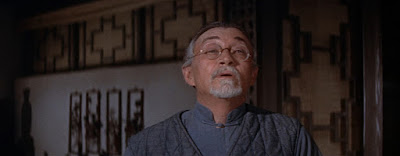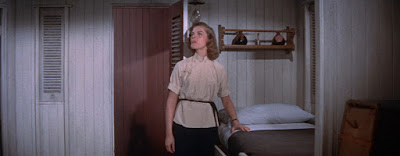John Wayne as Captain Tom Wilder
Lauren Bacall as Cathy Grainger
Mike Mazurki as Big Han
Paul Fix as Mr. Tso
Joy Kim as Susu
Henry Nakamura as "Tack"
Berry Kroeger as Old Feng
Based on the novel (and adapted to film) by future Whipping Boy author Sid Fleischman, Blood Alley stars Wayne as American Merchant Captain Tom Wilder, who, after his ship is seized by Chinese Communists, is "shanghaied" (IMDB's words, not mine) into transporting the villagers of Chiku San to Hong Kong (via riverboat and without even a real map) through "Blood Alley" (the Strait of Formosa). All the while, he finds himself attracted to tough physician's daughter Cathy, who herself fights her attraction to the rugged captain.
Wilder not-so-low-key insults a Red Army prison guard
while talking to him about "Baby".
Just from reading the synopsis, you can probably guess Blood Alley is one of several anti-Communist propaganda-themed films Wayne headlined of the era (1952's Big Jim McLain had this ill-advised poster and him in Hawaii tangling with future Alfred Alan Napier), and in some respects, it is exactly what one would expect, while in others, there's some effort (to this reviewer's surprise) to try and show a fairer portrayal of the Chinese people for the time.
San Francisco Bay's China Camp stands in for the fictional Chiku San village.
Filling in for a fired Robert Mitchum, Wayne very much gives a "John Wayne performance", with a few exceptions.
Wilder learns the fate of Cathy's father. Awwww...
Wayne's chemistry with Bacall isn't non-existent, but the structure of the story, coupled with Wayne's Captain Wilder having an imaginary girlfriend named "Baby", brings an odd element to your garden-variety "slap-slap-kiss" sexual tension (albeit not in such quick procession). Whether as a result or not, Wayne and Bacall don't quite gel enough to elevate the material.
See what I mean though?
Wayne and Bacall later reunited for 1976's The Shootist.
They replaced me in Cactus Flower with who?!
As ridden with "Engrish" as her dialogue is, Kim is great as Susu. One of the few villagers who stands up to Wilder (and him hilariously submitting to her in turn), she pretty much steals the show whenever she's on, getting a chance to sing to the ship passengers later in the film.
Wayne's transformation into Oskar Werner on Columbo
would sadly be short-lived.
Less embarrassingly written is Nakamura's "Tack", an amusingly "Americanized" villager who's an expert marine engineer with an affinity for cigars. Nakamura is so charming in the role, that it just makes the Caucasian actors playing the other villagers stand out even more jarringly.
While I appreciate that Blood Alley doesn't employ "Yellowface" makeup
(for the most part), Fix is so clearly raising his eyebrows to "make slants"
that you wonder how he hasn't gotten a headache yet.
Believe it or not, Ekberg won the Golden Globe for Most Promising Newcomer that year.
Blood Alley moves along quite well, thanks to Wellman's solid direction and William H. Clothier's great cinematography. Given the image quality, you would be forgiven for thinking this was from a soft DVD transfer, but it's actually due to the technological challenges of restoring films made with Cinemascope lenses (seen in this film's panning shots), 50s Eastmancolor film stock, and the short-lived WarnerColor process.
Some of Blood Alley's scenes employ so much soft-focus that
you'd swear you were watching an Emmanuelle film.
The amount of extras in this film, coupled with the use of real ships, was undoubtedly
a massive undertaking that should be credited for its execution.
Blood Alley has an excellent, dialogue-free sequence where members
of the Feng family try and take control of the ship, scored only by thunderclaps
(and at one point, the sound of a goat).
The sequence also provides a nice moment of chemistry between Wayne and Bacall.
Because the village of Chiku San is fictional (though the real-life Blood Alley is actually in Shanghai), Blood Alley may get around some scrutiny regarding accuracy, and I shouldn't expect total accuracy in a 50s propaganda movie, but needless to say, this Chinese-Canadian had a field day making fun of the "little things" in this film.
While I commend the white actors for learning a sizable amount of Chinese (all unsubtitled),
their thick accents clash with the Chinese-American actors speaking Mandarin.
(And Betty, I love you, but girl, you sound Cantonese.)
For those who don't know, because China is such a large, diverse country, its dialects are regarded as mutually unintelligible. You could make the argument that the Communist soldiers might understand more than one dialect, but hearing the different accents in this film is like watching a film set in historical London (back when French was the official language), and its actors from Ireland, Wales, Scotland, and Northern England not even attempting to do a London accent (but even worse).
W.T. Chang as Mr. Han and George Chan as Mr. Sing
No real explanation is given as to why Chiku San's people want to flee
to Hong Kong, other than disliking the government in Beijing. In real life,
the rural villagers would more likely be focused on rebuilding after
the events of both WWII and the Chinese Civil War.
Neighborhood Gossip
Old Feng, patriarch of a large, "Peiping-friendly" family, is no one's idea of a "dyed-in-the-silk" Communist. Just from material obsessions alone, he's closer to the Communists' idea of what a Nationalist looks like.
"Yellowface" aside, Kroeger is (darkly) hilarious as Feng, hitting
his own relatives for not adequately caring for his engine-less car.
Interestingly, this "token bad Commie" is a fan of the
American national pastime of using a Viewmaster.
Also, little explanation is offered as to why the Fengs are taken along on the ship (other than for plot inconvenience), so one could infer that any major conflict could have been avoided had the Fengs just run off to Beijing.
LOGO GEMS
Blood Alley uses the 1953 - 1956 three-dimensional variant of the 1948 - 1967 Warner Bros. Shield, usually reserved for 3-D and some 2-D films.
OTHER OBSERVATIONS
An uncredited James Hong has a small speaking role as a Communist soldier.
Wayne bayoneting a lecherous soldier trying to assault Bacall is only
slightly less funny than Wayne firing a too-small MAC-10 in McQ (1974).
Uh, yeah, no. I have zero issue with Bacall's scenes here.
Before Paul Sorvino in Goodfellas, there was "Tack" and his "magic cigar",
moving from his hand to his mouth between shots.
Chekhov's Throwing Knives
"Help! I'm being seajacked by a six-foot-tall monk
who keeps calling everyone "Pilgrim"!"
The other important Western Union telegram regarding
a disappearance in 1955.
Bacall reacts appropriately to the imaginary girlfriend who stole her real-life nickname.
After seeing all the real ships in the film, the finale's obvious models
will give the audience some real Theodore Tugboat flashbacks.
TIDBITS AND SUCH
Wayne promoted Blood Alley in the I Love Lucy episode "Lucy and John Wayne".
While Blood Alley has some gorgeously-colored posters, some of them also seemingly depict Bacall as either inexplicably black-haired or as Princess Leia.
Blood Alley is an odd, "crossroads" depiction of how Hollywood saw the Asian community, nestled within your run-of-the-mill historical adventure movie, with a large dash of propaganda, and is best viewed as a historical artifact and a marker of the Cinemascope era.

















































No comments:
Post a Comment